Geological Controls on Mineralogical Characteristic Differences of Coals from the Main Coal Fields in Shaanxi, North China
Abstract
:1. Introduction
2. Geological Setting
3. Methodology
4. Results
4.1. Standard Coal Characteristics
4.2. Coal Petrology
4.3. Coal Mineralogy
4.3.1. Carboniferous-Permian Coals
Mineral Composition
Modes of Occurrence of Minerals
Vertical Distribution of Minerals
4.3.2. Triassic Coals
4.3.3. Jurassic Coals
Mineral Composition
Mineral Distribution
Modes of Occurrence of Minerals
5. Discussion
5.1. Origins of Typical Minerals in Different Coals
5.1.1. Clay Minerals
5.1.2. Carbonate Minerals
5.2. Change in Mineral Assemblages with Different Coal Fields and Geological Ages
5.3. Geological Controls on Mineralogical Characteristic Differences
5.3.1. Influence of Sedimentary Setting
5.3.2. Influence of Terrigenous Detrital Input
5.3.3. Influence of Hydrothermal Fluids
6. Conclusions
Author Contributions
Funding
Acknowledgments
Conflicts of Interest
References
- Lv, J.; Zhao, Y. Characteristic Analysis of Elements in Coal in Huanglong Jurassic Coalfield. Coal Geol. China 2015, 27, 15–18. [Google Scholar]
- Bai, G.; Liu, X.; Fan, Z.; Li, X. Epidemiologic survey on coal- burning endemic arsenism in Shaanxi Province. Chin. J. Endem. 2006, 25, 57–60. [Google Scholar]
- Luo, K.; Ren, D.; Xu, L.; Dai, S.; Cao, D.; Feng, F.; Tan, J. Fluorine content and distribution pattern in Chinese coals. Int. J. Coal Geol. 2004, 57, 143–149. [Google Scholar] [CrossRef]
- Wang, X.; Dai, S.; Ren, D.; Yang, J. Mineralogy and geochemistry of Al-hydroxide/oxyhydroxide mineral-bearing coals of Late Paleozoic age from the Weibei coalfield, southeastern Ordos Basin, North China. Appl. Geochem. 2011, 26, 1086–1096. [Google Scholar] [CrossRef]
- Zhang, X.; Wu, H.; Li, W. Analysis of coal reserves in Shaanxi Province. Inn. Mong. Coal Econ. 2015, 6, 200–210. [Google Scholar]
- Li, J.; Wu, P.; Yang, G.; Pan, L.; Zhuang, X.; Querol, X.; Moreno, N.; Li, B.; Shangguan, Y. Enrichment of Li–Ga–Zr–Hf and Se–Mo–Cr–V–As–Pb Assemblages in the No. 11 Superhigh Organic Sulfur Coal from the Sangshuping Coal Mine, Weibei Coalfield, Shaanxi, North China. Energies 2020, 13, 6660. [Google Scholar] [CrossRef]
- Shangguan, Y.; Zhuang, X.; Li, J.; Li, B.; Querol, X.; Liu, B.; Moreno, N.; Yuan, W.; Yang, G.; Pan, L.; et al. Geological Controls on Mineralogy and Geochemistry of the Permian and Jurassic Coals in the Shanbei Coalfield, Shaanxi Province, North China. Minerals 2020, 10, 138. [Google Scholar] [CrossRef] [Green Version]
- Brownfield, M.E.; Affolter, R.H.; Stricker, G.D.; Hildebrand, R.T. High chromium contents in Tertiary coal deposits of northwestern Washington—A key to their depositional history. Int. J. Coal Geol. 1995, 27, 153–169. [Google Scholar] [CrossRef]
- Querol, X.; Whateley, M.; Fernandez-Turiel, J.-L.; Tuncali, E. Geological controls on the mineralogy and geochemistry of the Beypazari lignite, central Anatolia, Turkey. Int. J. Coal Geol. 1997, 33, 255–271. [Google Scholar] [CrossRef]
- Ward, C.R. Analysis and significance of mineral matter in coal seams. Int. J. Coal Geol. 2002, 50, 135–168. [Google Scholar] [CrossRef]
- Yudovich, Y.E.; Ketris, M.P. Inorganic Matter of Coal; Urals Branch of RAS: Ekaterinburg, Russia, 2002; p. 422. [Google Scholar]
- Spears, D. The origin of tonsteins, an overview, and links with seatearths, fireclays and fragmental clay rocks. Int. J. Coal Geol. 2012, 94, 22–31. [Google Scholar] [CrossRef]
- Dai, S.; Ren, D.; Chou, C.-L.; Finkelman, R.B.; Seredin, V.V.; Zhou, Y. Geochemistry of trace elements in Chinese coals: A review of abundances, genetic types, impacts on human health, and industrial utilization. Int. J. Coal Geol. 2012, 94, 3–21. [Google Scholar] [CrossRef]
- Dai, S.; Ward, C.R.; Graham ITFrench, D.; Hower, J.C.; Zhao, L.; Wang, X. Altered volcanic ashes in coal and coal-bearing sequences: A review of their nature and significance. Earth Sci. Rev. 2017, 175, 44–74. [Google Scholar] [CrossRef]
- Dai, S.; Ji, D.; Ward, C.R.; French, D.; Hower, J.C.; Yan, X.; Wei, Q. Mississippian anthracites in Guangxi Province, southern China: Petrological, mineralogical, and rare earth element evidence for high-temperature solutions. Int. J. Coal Geol. 2018, 197, 84–114. [Google Scholar] [CrossRef]
- Dai, S.; Bechtel, A.; Eble, C.F.; Flores, R.M.; French, D.; Graham, I.T.; Hood, M.M.; Hower, J.C.; Korasidis, V.A.; Moore, T.A.; et al. Recognition of peat depositional environments in coal: A review. Int. J. Coal Geol. 2020, 219, 103383. [Google Scholar] [CrossRef]
- Finkelman, R.B.; Dai, S.; French, D. The importance of minerals in coal as the hosts of chemical elements: A review. Int. J. Coal Geol. 2019, 212, 103251. [Google Scholar] [CrossRef]
- Çelik, Y.; Karayigit, A.I.; Oskay, R.G.; Kayseri-Özer, M.S.; Christanis, K.; Hower, J.C.; Querol, X. A multidisciplinary study and palaeoenvironmental interpretation of middle Miocene Keles lignite (Harmancık Basin, NW Turkey), with emphasis on syngenetic zeolite formation. Int. J. Coal Geol. 2021, 237, 103691. [Google Scholar] [CrossRef]
- Karayiğit, A.I.; Bircan, C.; Oskay, R.G.; Türkmen, I.; Querol, X. The geology, mineralogy, petrography, and geochemistry of the MioceneDursunbey coal within fluvio-lacustrine deposits, Balıkesir (Western Turkey). Int. J. Coal Geol. 2020, 228, 103548. [Google Scholar] [CrossRef]
- Liu, S.; Ma, W.; French, D.; Tuo, K.; Mei, X. Sequential Mineral Transformation during Underground Coal Gasification with the Presence of Coal Partings. Int. J. Coal Geol. 2019, 208, 1–11. [Google Scholar] [CrossRef]
- Dai, S.; Finkelman, R.B.; French, D.; Hower, J.C.; Graham, I.T.; Zhao, F. Modes of occurrence of elements in coal: A critical evaluation. Earth-Sci. Rev. 2021, 222, 103815. [Google Scholar] [CrossRef]
- Finkelman, R.B.; Palmer, C.A.; Wang, P. Quantification of the modes of occurrence of 42 elements in coal. Int. J. Coal Geol. 2018, 185, 138–160. [Google Scholar] [CrossRef]
- Goodarzi, F. Assessment of elemental content of milled coal, combustion residues, and stack emitted materials: Possible environmental effects for a Canadian pulverized coal-fired power plant. Int. J. Coal Geol. 2006, 65, 17–25. [Google Scholar] [CrossRef]
- Wang, C.; Liu, H.; Zhang, Y.; Zou, C.; Anthony, E.J. Review of arsenic behavior during coal combustion: Volatilization, transformation, emission and removal technologies. Prog. Energy Combust. Sci. 2018, 68, 1–28. [Google Scholar] [CrossRef] [Green Version]
- Seredin, V.V.; Dai, S. Coal deposits as potential alternative sources for lanthanides and yttrium. Int. J. Coal Geol. 2012, 94, 67–93. [Google Scholar] [CrossRef]
- Hower, J.C.; Qian, D.; Briot, N.; Henke, K.R.; Hood, M.M.; Taggart, R.K.; Hsu-Kim, H. Rare earth element associations in the Kentucky State University stoker ash. Int. J. Coal Geol. 2018, 189, 75–82. [Google Scholar] [CrossRef]
- Finkelman, R.B.; Orem, W.; Castranova, V.; A Tatu, C.; Belkin, H.; Zheng, B.; E Lerch, H.; Maharaj, S.V.; Bates, A.L. Health impacts of coal and coal use: Possible solutions. Int. J. Coal Geol. 2002, 50, 425–443. [Google Scholar] [CrossRef]
- Finkelman, R.B.; Tian, L. The health impacts of coal use in China. Int. Geol. Rev. 2017, 60, 579–589. [Google Scholar] [CrossRef]
- Lu, X. Characteristics of environmental geochemistry of Se in Coals of Shaanxi province. J. Shaanxi Norm. Univ. 2003, 31, 107–112. [Google Scholar]
- Luo, K.; Wang, W.; Yao, G.; Duanmu, H.; Mi, J.; Zhang, H. Sulfur content of permo-carboniferous coal and its geneses in Hancheng mine. J. Xi’an Univ. Sci. Technol. 2000, 20, 289–292. [Google Scholar]
- Mi, J.; Ren, J.; Wang, J.C.; Bao, W.R.; Xie, K.C. Ultrasonic and Microwave Desulfurization of Coal in Tetrachloroethylene. Energy Sources Part A Recovery Util. Environ. Eff. 2007, 29, 1261–1268. [Google Scholar] [CrossRef]
- Yang, Z.Y.; Wang, S.T.; Tan, C.; Li, Y.H. Desulfurization Effect of High-Sulfur Weibei Coal of Assisted by Microwave Irradiation and Ultrasonic Wave. Adv. Mater. Res. 2014, 1070–1072, 501–504. [Google Scholar] [CrossRef]
- Dai, S.; Jiang, Y.; Ward, C.; Gu, L.; Seredin, V.V.; Liu, H.; Zhou, D.; Wang, X.; Sun, Y.; Zou, J.; et al. Mineralogical and geochemical compositions of the coal in the Guanbanwusu Mine, Inner Mongolia, China: Further evidence for the existence of an Al (Ga and REE) ore deposit in the Jungar Coalfield. Int. J. Coal Geol. 2012, 98, 10–40. [Google Scholar] [CrossRef]
- Dai, S.; Li, D.; Chou, C.-L.; Zhao, L.; Zhang, Y.; Ren, D.; Ma, Y.; Sun, Y. Mineralogy and geochemistry of boehmite-rich coals: New insights from the Haerwusu Surface Mine, Jungar Coalfield, Inner Mongolia, China. Int. J. Coal Geol. 2008, 74, 185–202. [Google Scholar] [CrossRef]
- Dai, S.; Li, T.; Jiang, Y.; Ward, C.; Hower, J.C.; Sun, J.; Liu, J.; Song, H.; Wei, J.; Li, Q.; et al. Mineralogical and geochemical compositions of the Pennsylvanian coal in the Hailiushu Mine, Daqingshan Coalfield, Inner Mongolia, China: Implications of sediment-source region and acid hydrothermal solutions. Int. J. Coal Geol. 2015, 137, 92–110. [Google Scholar] [CrossRef]
- Li, J.; Zhuang, X.; Yuan, W.; Liu, B.; Querol, X.; Font, O.; Moreno, N.; Li, J.; Gang, T.; Liang, G. Mineral composition and geochemical characteristics of the Li-Ga-rich coals in the Buertaohai-Tianjiashipan mining district, Jungar Coalfield, Inner Mongolia. Int. J. Coal Geol. 2016, 167, 157–175. [Google Scholar] [CrossRef]
- Zhao, L.; Dai, S.; Nechaev, V.P.; Nechaeva, E.V.; Graham, I.T.; French, D. Enrichment origin of critical elements (Li and rare earth elements) and a Mo-U-Se-Re assemblage in Pennsylvanian anthracite from the Jincheng Coalfield, southeastern Qinshui Basin, northern China. Ore Geol. Rev. 2019, 115, 103184. [Google Scholar] [CrossRef]
- Liang, J. Studies on Sedimentology and Sequence Stratigraphy of the Jurassic in Ordos Basin. Ph.D. Thesis, Northwest University, Xi’an, China, 2007. [Google Scholar]
- Li, L.; Shao, L.; Li, M.; Wang, D.; Lu, J.; Li, Z.; Cheng, A. Sequence-paleogeography and coal accumulation of the upper Triassic Wayaopu Formation in Ordos basin. J. China Coal Soc. 2017, 42, 2090–2100. [Google Scholar]
- Wang, S. Coal Accumulating and Coal Resource Evaluation of Ordos Basin; China Coal Industry Publishing House: Chaoyang Beijing, China, 1996; pp. 1–473. [Google Scholar]
- STM Standard D3173-11. Test Method for Moisture in the Analysis Sample of Coal and Coke; ASTM International: West Conshohocken, PA, USA, 2011; Available online: www.astm.org (accessed on 20 September 2021).
- ASTM Standard D3175-11. Test Method for Volatile Matter in the Analysis Sample of Coal and Coke; ASTM International: West Conshohocken, PA, USA, 2011; Available online: www.astm.org (accessed on 20 September 2021).
- ASTM Standard D3174-11. Annual book of ASTM standards. In Test Method for Ash in the Analysis Sample of Coal and Coke; ASTM International: West Conshohocken, PA, USA, 2011; Available online: www.astm.org (accessed on 20 September 2021).
- ASTM Standard D4239-18a. Standard Test Method for Sulfur in the Analysis Sample of Coal and Coke Using High-Temperature Tube Furnace Combustion; ASTM International: West Conshohocken, PA, USA, 2018; Available online: www.astm.org (accessed on 20 September 2021).
- ASTM Standard D2492-02. Annual Book of ASTM Standards. In Standard Test Method for Forms of Sulfur in Coal: Gaseous Fuels: Coal and Coke; ASTM International: West Conshohocken, PA, USA, 2005; Available online: www.astm.org (accessed on 20 September 2021).
- ASTM D2798-20. Standard Test Method for Microscopical Determination of the Vitrinite Reflectance of Coal; ASTM International: West Conshohocken, PA, USA, 2020; Available online: www.astm.org (accessed on 20 September 2021).
- Chung, F.H. Quantitative interpretation of X-ray diffraction patterns of mixtures: I. Matrix flushing method for quantitative multicomponent analysis. J. Appl. Crystalogr. 1974, 7, 519–525. [Google Scholar] [CrossRef]
- MT/T 850-2000 (China). Classification for Moisture of Coal; China Coal Research Institute: Beijing, China, 2000. [Google Scholar]
- GB/T 15224.1-2010 (China). Classification for Quality of Coal. Part 1: Ash Yield; SAC/TC469; ASTM International: Taiyuan, China, 2010. [Google Scholar]
- ASTM Standard D388-12. Standard Classification of Coals by Rank; ASTM International: West Conshohocken, PA, USA, 2012; Available online: www.astm.org (accessed on 20 September 2021).
- Yang, Q. The coal metamorphism in China; China Coal Industry Publishing House: Beijing, China, 1996; pp. 1–212. [Google Scholar]
- Chou, C.L. Sulfur in coals: A review of geochemistry and origins. Int. J. Coal Geol. 2012, 100, 1–13. [Google Scholar] [CrossRef]
- Fan, L.; Kou, G.; Hou, F. Probe into Features and Geneses of Sulfur Content in Low-sulfur Coal of Yushen Mining Area. Coal Geol. China 2003, 15, 12–13. [Google Scholar]
- Wang, Y.; Gao, S. The distribution of coal sorts and analysis of its geologic background in Shaanxi province. J. Xi’an Univ. Sci. Technol. 2003, 23, 400–403. [Google Scholar]
- Li, J.; Zhuang, X.; Querol, X.; Moreno, N.; Yang, G.; Pan, L.; Li, B.; Shangguan, Y.; Pan, Z.; Liu, B. Enrichment of Nb-Ta-Zr-W-Li in the Late Carboniferous Coals from the Weibei Coalfield, Shaanxi, North China. Energies 2020, 13, 4818. [Google Scholar] [CrossRef]
- Permana, A.K.; Ward, C.; Li, Z.; Gurba, L.W. Distribution and origin of minerals in high-rank coals of the South Walker Creek area, Bowen Basin, Australia. Int. J. Coal Geol. 2013, 116-117, 185–207. [Google Scholar] [CrossRef]
- Karayiğita, A.İ.; Mastalerz, M.; Oskaya, R.G.; Buzkan, İ. Bituminous coal seams from underground mines in the Zonguldak Basin (NW Turkey): Insights from mineralogy, coal petrography, Rock-Eval pyrolysis, and meso-and microporosity. Int. J. Coal Geol. 2018, 199, 91–112. [Google Scholar] [CrossRef]
- Dawson, G.K.W.; Golding, S.D.; Esterle, J.S.; Massarotto, P. Occurrence of minerals within fractures and matrix of selected Bowen and Ruhr Basin coals. Int. J. Coal Geol. 2012, 94, 150–166. [Google Scholar] [CrossRef]
- Zhao, L.; Sun, J.; Guo, W.; Wang, P.; Ji, D. Mineralogy of the Pennsylvanian coal seam in the Datanhao mine, Daqingshan Coalfield, Inner Mongolia, China: Genetic implications for mineral matter in coal deposited in an intermontane basin. Int. J. Coal Geol. 2016, 167, 201–214. [Google Scholar] [CrossRef]
- Zhu, H.; Zhang, W.; Ning, S.; Han, L.; Deng, X. Aluminum Distribution in North China Permo-Carboniferous Coal and Its Resource Prospect. Coal Geol. China 2018, 30, 21–25+29. [Google Scholar]
- Dai, S.; Zou, J.; Jiang, Y.; Ward, C.; Wang, X.; Li, T.; Xue, W.; Liu, S.; Tian, H.; Sun, X.; et al. Mineralogical and geochemical compositions of the Pennsylvanian coal in the Adaohai Mine, Daqingshan Coalfield, Inner Mongolia, China: Modes of occurrence and origin of diaspore, gorceixite, and ammonian illite. Int. J. Coal Geol. 2012, 94, 250–270. [Google Scholar] [CrossRef]
- Zheng, Q.; Liu, Q.; Shi, S. Mineralogy and geochemistry of ammonianillite in intraseam partings in Permo-Carboniferous coal of the Qinshui coalfield, North China. Int. J. Coal Geol. 2016, 153, 1–11. [Google Scholar] [CrossRef]
- Golab, A.; Ward, C.R.; Permana, A.; Lennox, P.; Botha, P. High-resolution threedimensional imaging of coal using microfocus X-ray computed tomography, with special reference to modes of mineral occurrence. Int. J. Coal Geol. 2013, 113, 97–108. [Google Scholar] [CrossRef]
- Karayiğit, A.I.; Littke, R.; Querol, X.; Jones, T.; Oskay, R.G.; Christanis, K. The Miocene coal seams in the Soma Basin (W. Turkey): Insights from coal petrography, mineralogy and geochemistry. Int. J. Coal Geol. 2017, 173, 110–128. [Google Scholar] [CrossRef]
- Dai, S.; Zhang, W.; Seredin, V.V.; Ward, C.; Hower, J.C.; Song, W.; Wang, X.; Li, X.; Zhao, L.; Kang, H.; et al. Factors controlling geochemical and mineralogical compositions of coals preserved within marine carbonate successions: A case study from the Heshan Coalfield, southern China. Int. J. Coal Geol. 2013, 109-110, 77–100. [Google Scholar] [CrossRef]
- Dai, S.; Zhang, W.; Ward, C.; Seredin, V.V.; Hower, J.C.; Li, X.; Song, W.; Wang, X.; Kang, H.; Zheng, L.; et al. Mineralogical and geochemical anomalies of late Permian coals from the Fusui Coalfield, Guangxi Province, southern China: Influences of terrigenous materials and hydrothermal fluids. Int. J. Coal Geol. 2013, 105, 60–84. [Google Scholar] [CrossRef]
- Dai, S.; Xie, P.; Ward, C.R.; Yan, X.; Guo, W.; French, D.; Graham, I.T. Anomalies of rare metals in Lopingian super-high-organic-sulfur coals from the Yishan Coalfield, Guangxi, China. Ore Geol. Rev. 2017, 88, 235–250. [Google Scholar] [CrossRef]
- Li, W.; Tang, Y. Characteristics of the rare earth elements in a high organic sulfur coal from Chenxi, Hunan province. J. Fuel Chem. Technol. 2013, 41, 540–549. [Google Scholar]
- Tang, Y.; He, X.; Cheng, A.; Li, W.; Deng, X.; Wei, Q.; Li, L. Occurrence and sedimentary control of sulfur in coals of China. J. China Coal Soc. 2015, 40, 1977–1988. [Google Scholar]
- China National Administration of Coal Geology (CNACG). Late Paleozoic Coal Geology of North China Platform; Shanxi Science and Technology Press: Taiyuan, China, 1997. [Google Scholar]
- Zhu, X.-Q.; Zhu, W.-B.; Ge, R.-F.; Wang, X. Late paleozoic provenance shift in the south-central North China Craton: Implications for tectonic evolution and crustal growth. Gondwana Res. 2014, 25, 383–400. [Google Scholar] [CrossRef]
- Wan, Y. Study on the Spatial Coupling Relation of between the Sediment Source and Diagenesis of Yanchang Formation in southern Ordos Basin. Master’s Thesis, Chengdu University of Technology, Chengdu, China, 2011. [Google Scholar]
- Dai, S.; Xie, P.; Jia, S.; Ward, C.; Hower, J.C.; Yan, X.; French, D. Enrichment of U-Re-V-Cr-Se and rare earth elements in the Late Permian coals of the Moxinpo Coalfield, Chongqing, China: Genetic implications from geochemical and mineralogical data. Ore Geol. Rev. 2017, 80, 1–17. [Google Scholar] [CrossRef]
- Li, J.; Zhuang, X.; Querol, X.; Font, O.; Izquierdo, M.; Wang, Z. New data on mineralogy and geochemistry of high-Ge coals in the Yimin coalfield, Inner Mongolia, China. Int. J. Coal Geol. 2014, 125, 10–21. [Google Scholar] [CrossRef]
- Boudou, J.-P.; Schimmelmann, A.; Ader, M.; Mastalerz, M.; Sebilo, M.; Gengembre, L. Organic nitrogen chemistry during low-grade metamorphism. Geochim. Cosmochim. Acta 2008, 72, 1199–1221. [Google Scholar] [CrossRef] [Green Version]
- Daniels, E.J.; Altaner, S.P. Inorganic nitrogen in anthracite from eastern Pennsylvania, USA. Int. J. Coal Geol. 1993, 22, 21–35. [Google Scholar] [CrossRef]
- Nieto, F. Characterization of coexisting NH4- and K-micas in very low-grade metapelites. Am. Miner. 2002, 87, 205–216. [Google Scholar] [CrossRef] [Green Version]
- Ward, C.; Corcoran, J.; Saxby, J.; Read, H. Occurrence of phosphorus minerals in Australian coal seams. Int. J. Coal Geol. 1996, 30, 185–210. [Google Scholar] [CrossRef]
- Cheng, L.; Weibei, P.-C. Coalfield Geological Tectonic Development Control Characteristics of Groundwater. Master’s Thesis, Xi’an University of Science and Technology, Xi’an, China, 2013. [Google Scholar]
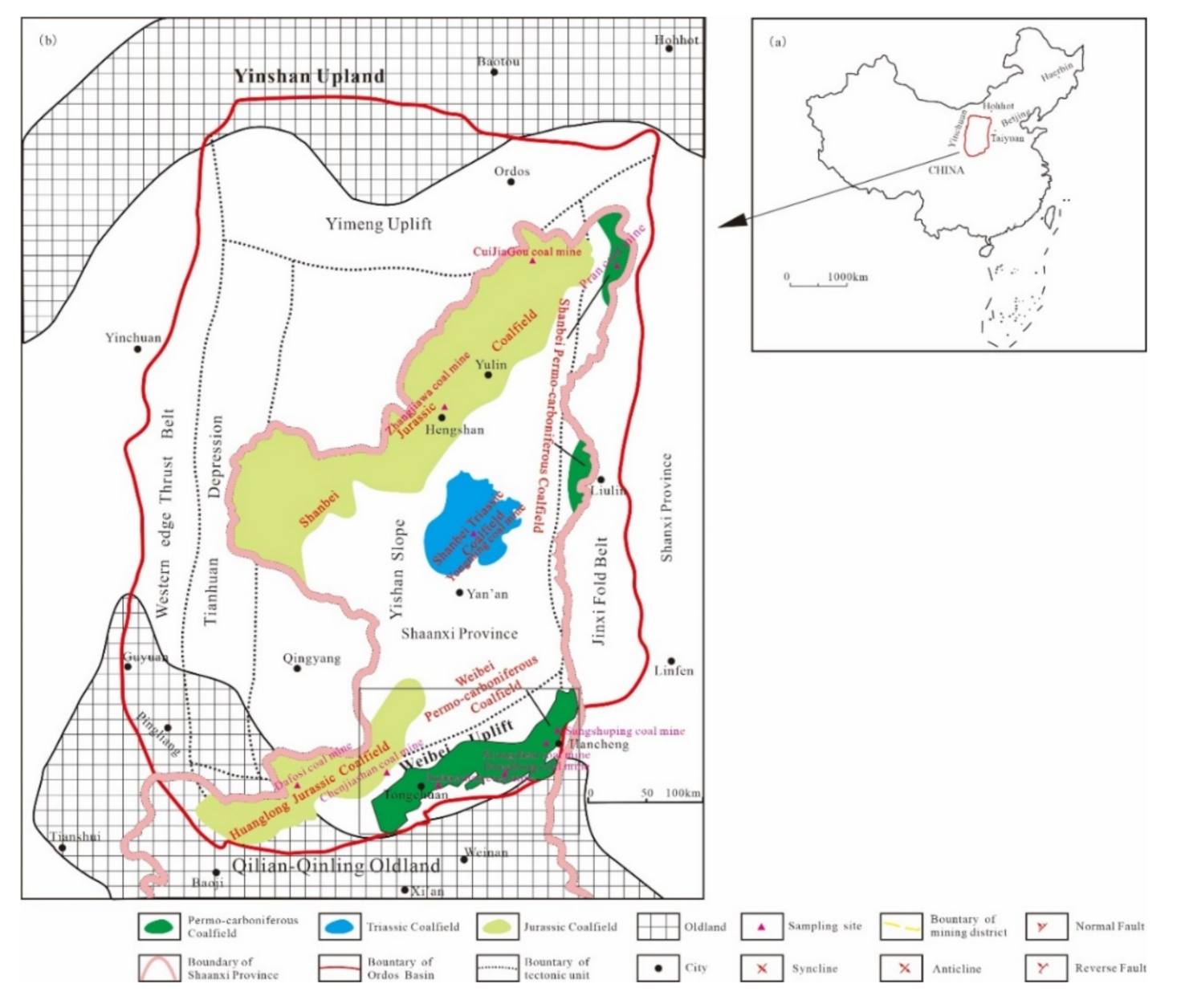

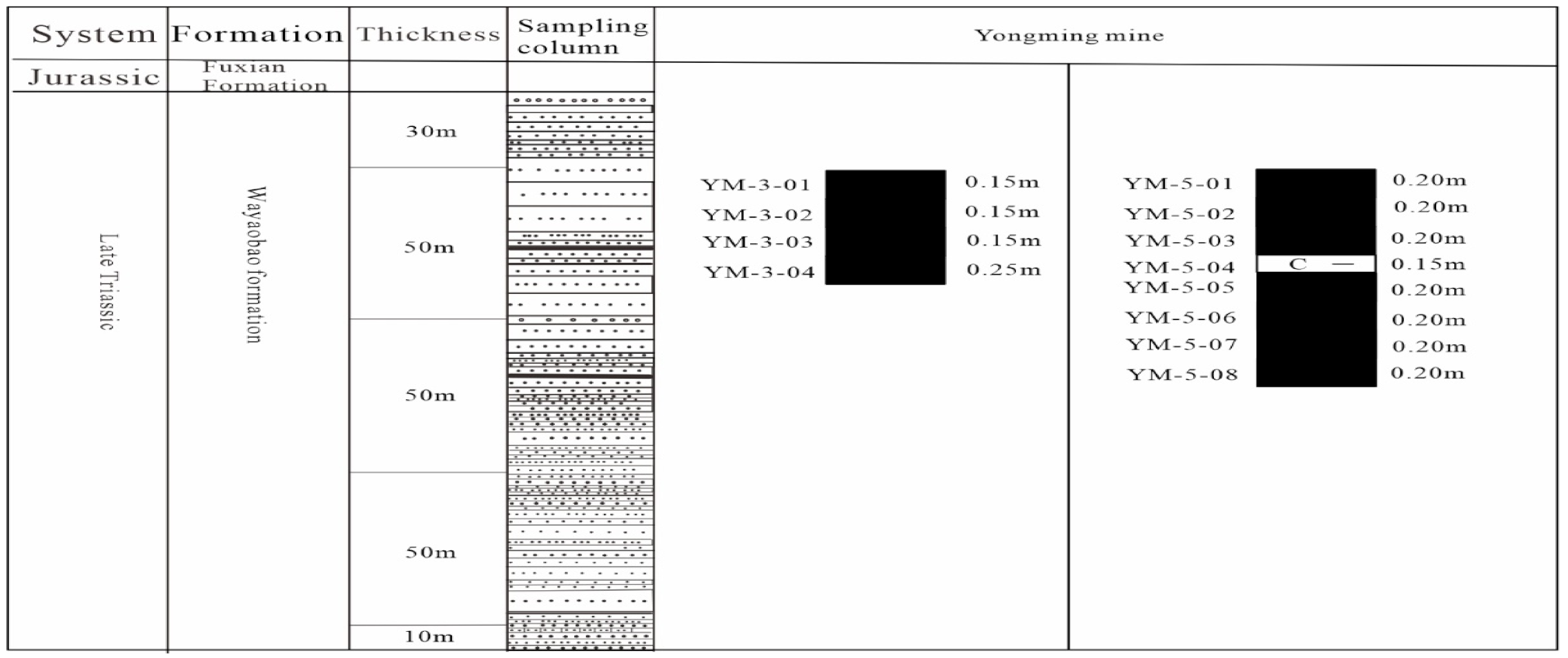

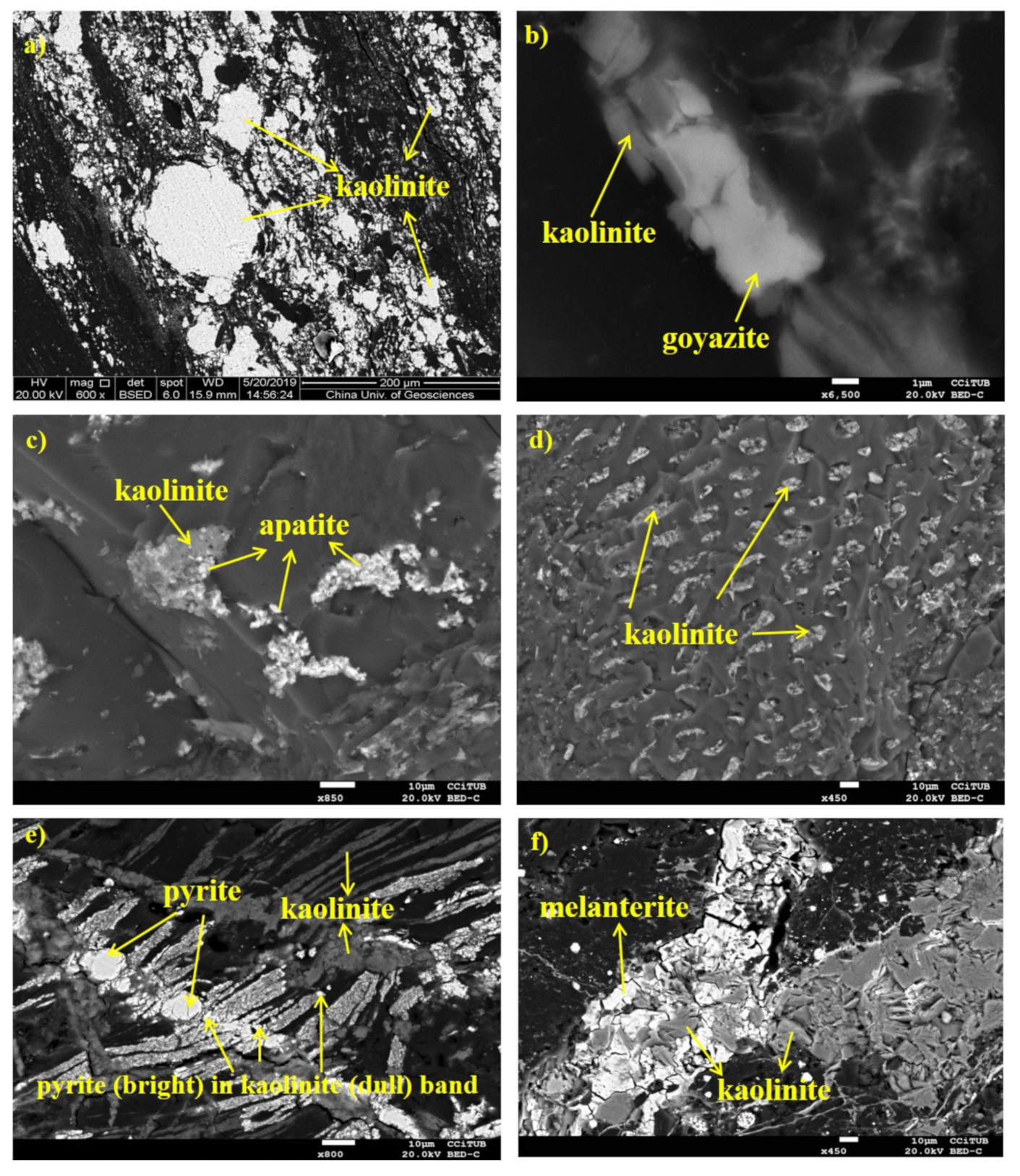
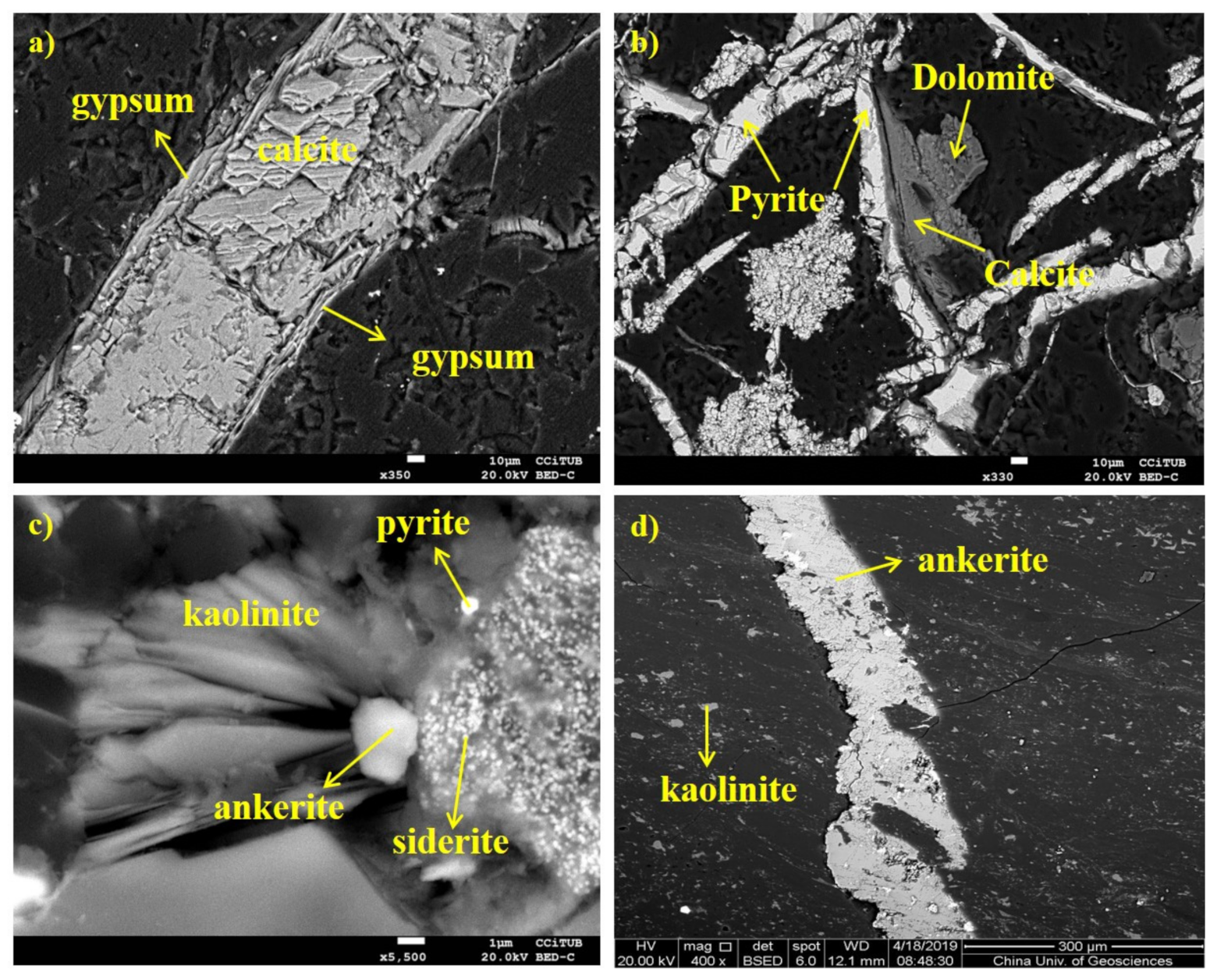

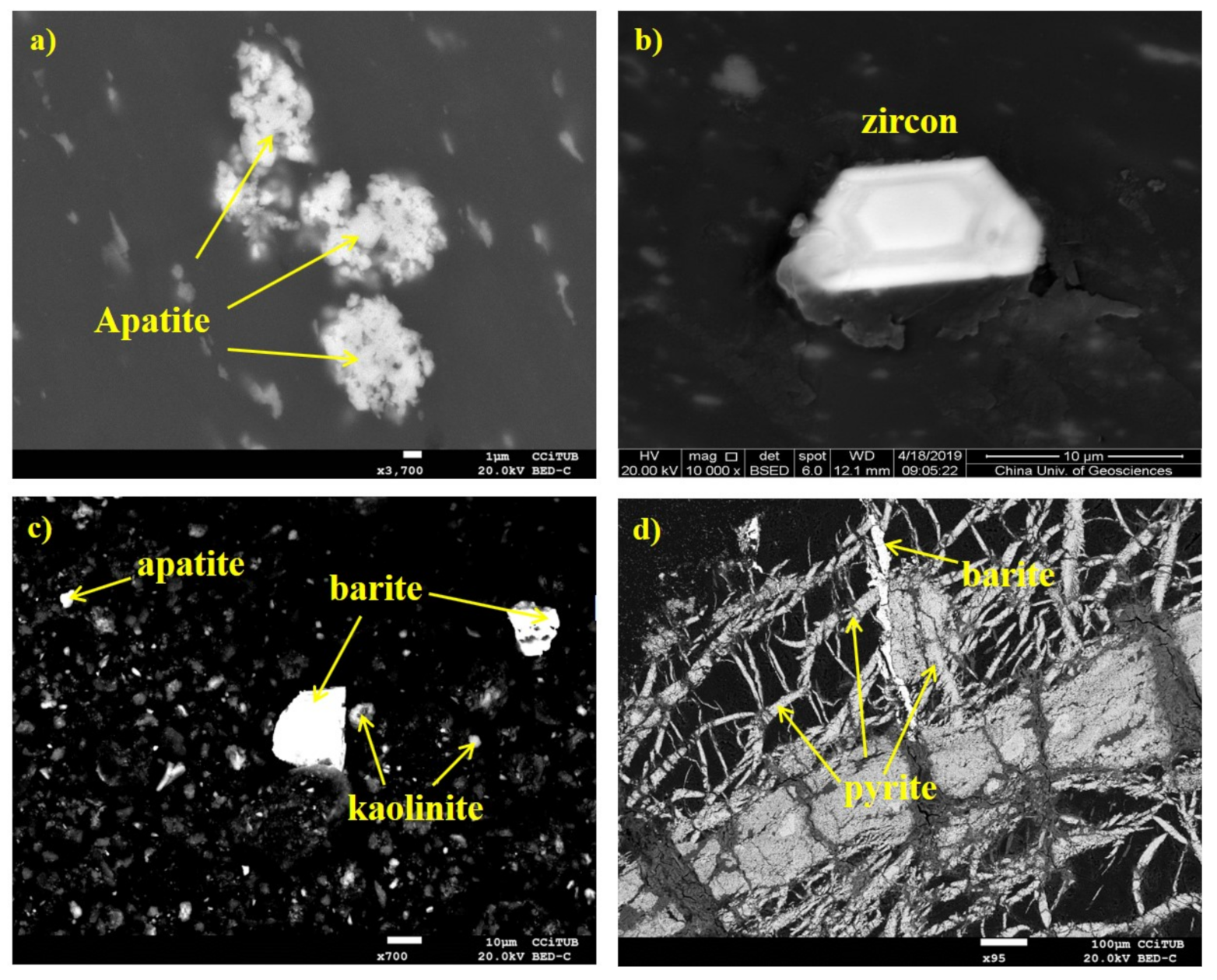

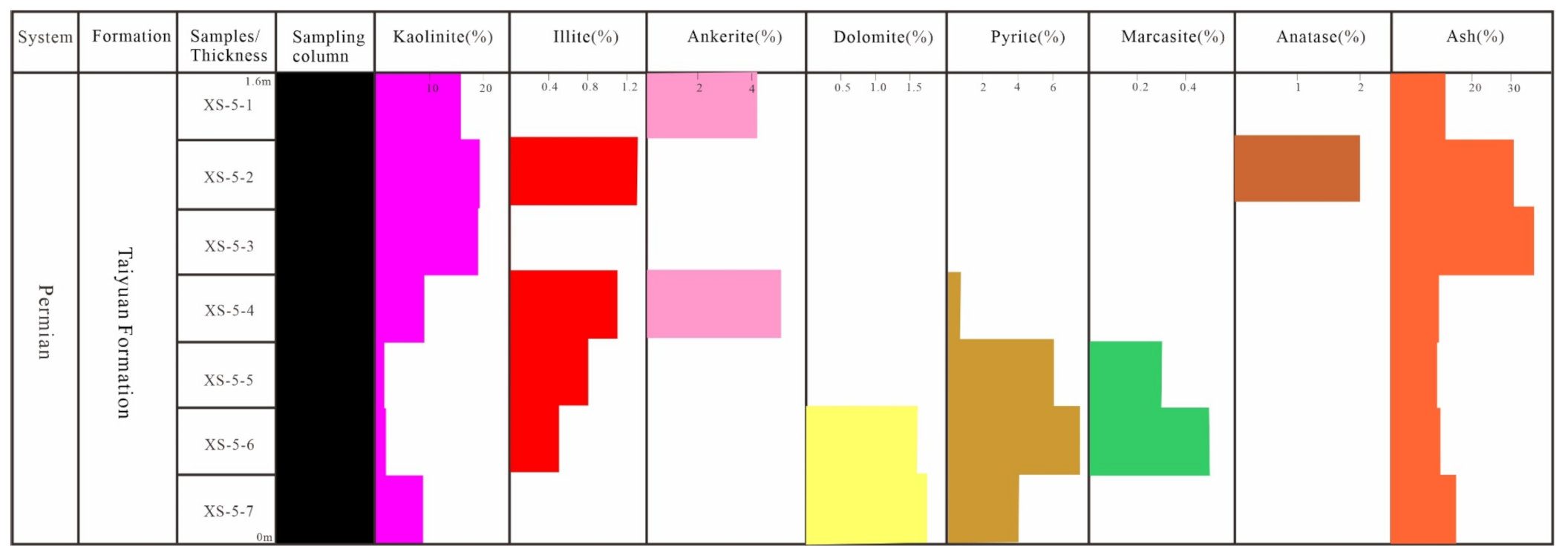



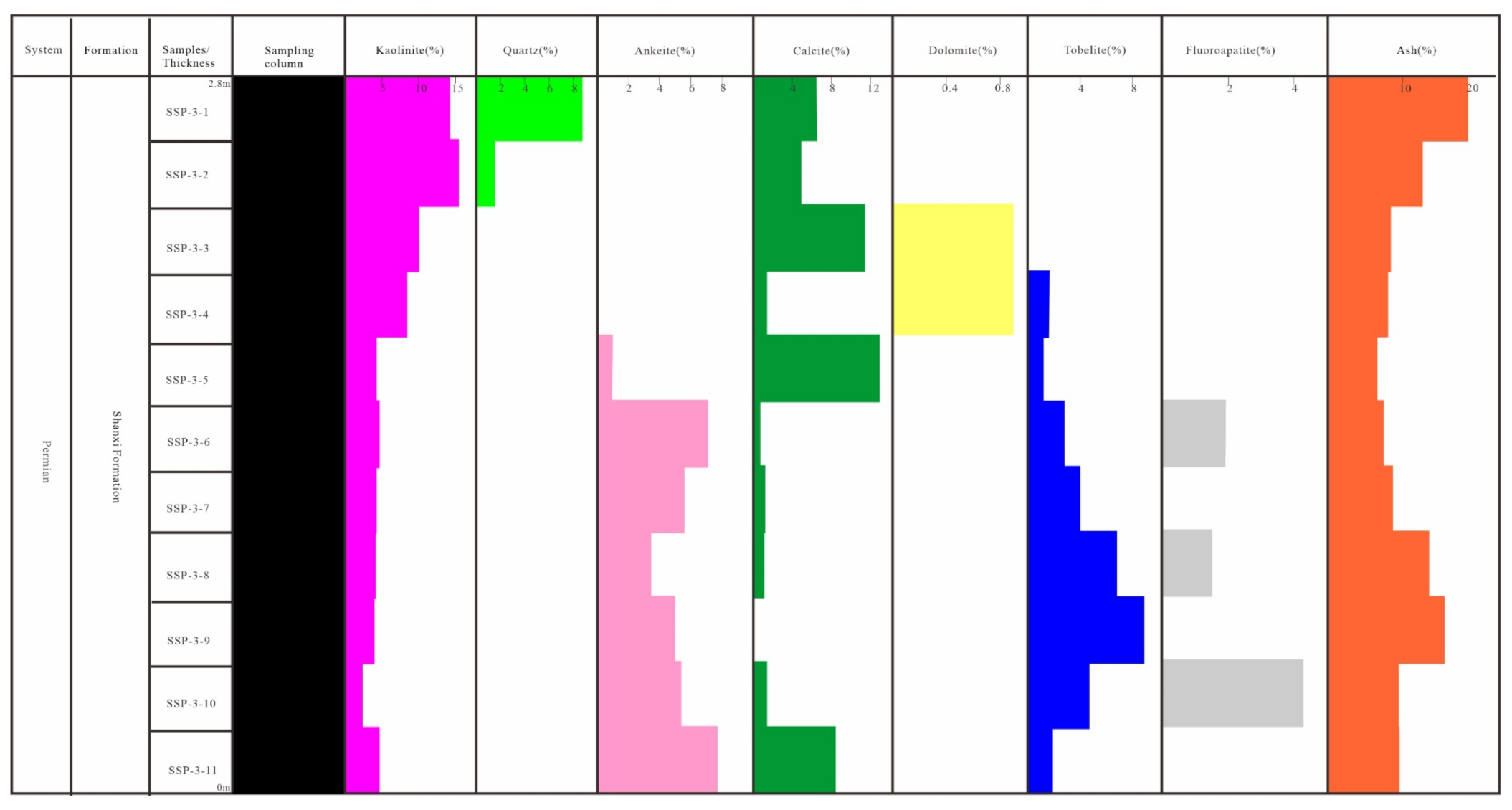

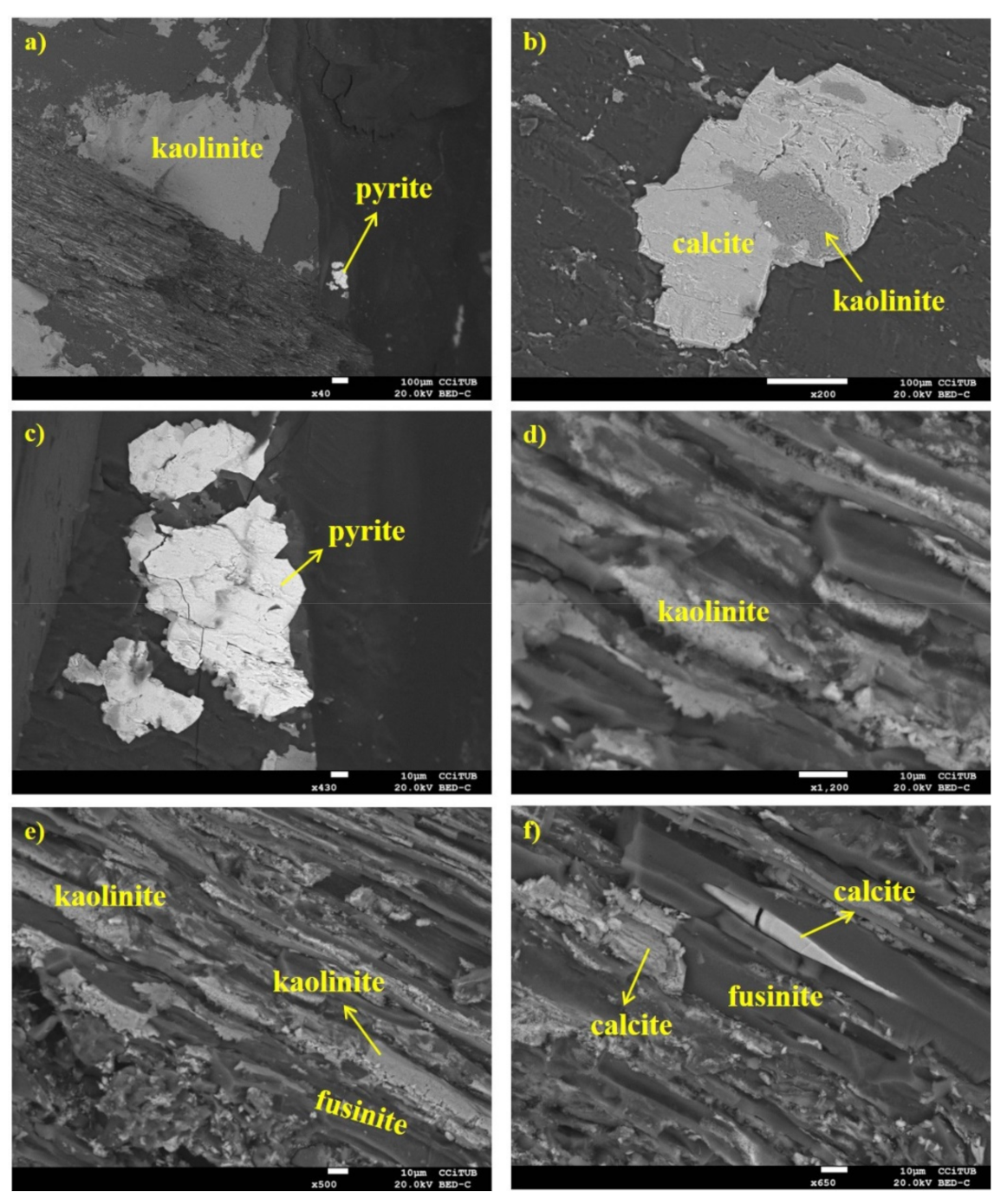







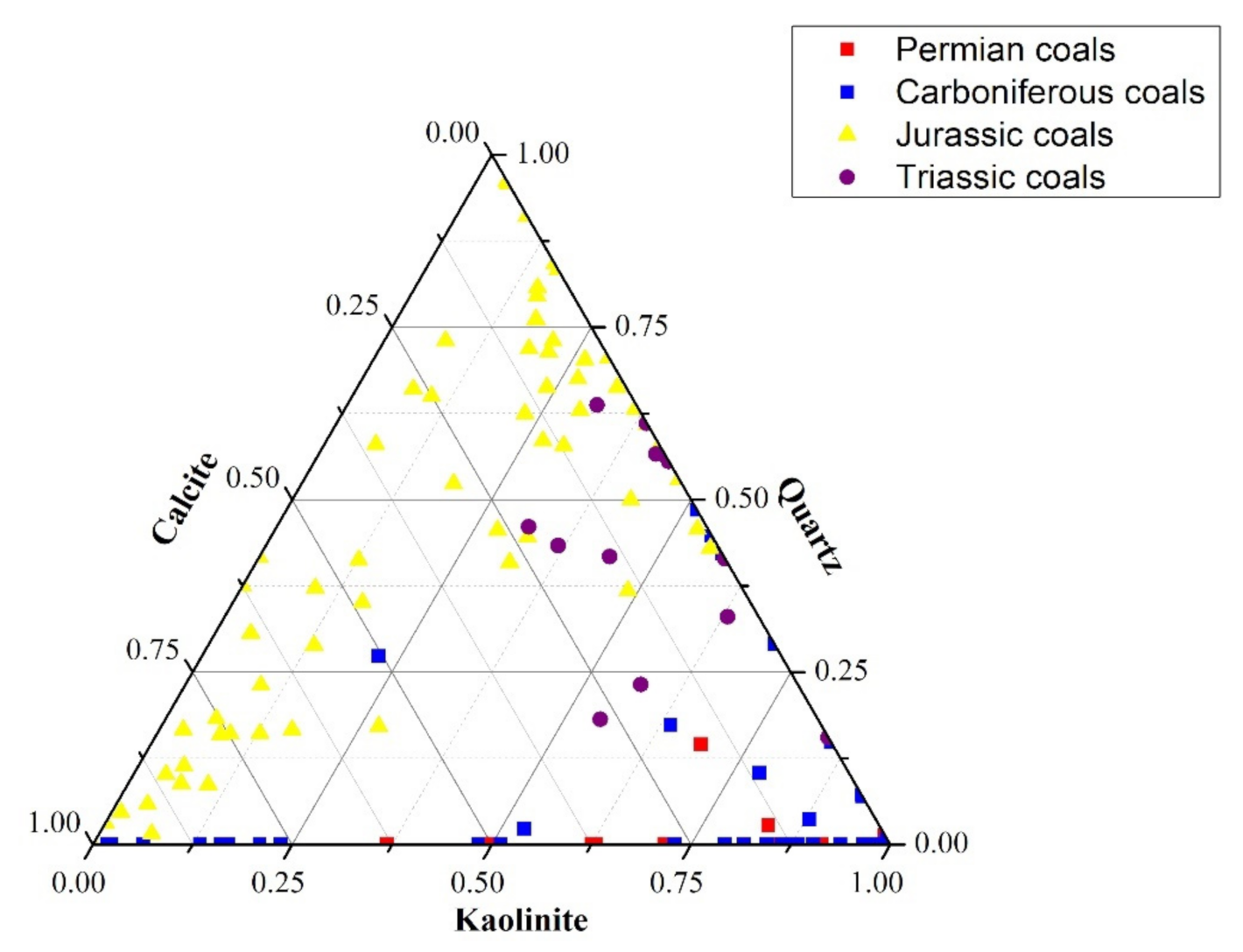
| Coal Seam | Coalfield | Coal Mine | M, ad% | A, d% | V, daf% | St, d% | Vitrinite, % | Inertinite,% | Liptinite,% | ||
|---|---|---|---|---|---|---|---|---|---|---|---|
| Carboniferous-Permian | Taiyuan Formation (C2t) | No. 5 | Weibei Carboniferous-Permian (C-P) | Jinghuashan (JHS) | 0.1–0.3 (0.2) | 7.1–33.0 (19.6) | 15.7–27.5 (19.4) | 0.7–3.6 (1.8) | 76.4 | 23.5 | 0.1 |
| No. 5 | Dongdong (DD) | 0.3–0.5 (0.4) | 7.6–30.6 (18.1) | 15.8–25.5 (19.7) | 1.1–9.7 (3.8) | 79.5 | 20.5 | 0.00 | |||
| No. 5 | Xiangshan (XS) | 0.9–1.5 (1.2) | 11.5–36.2 (19.0) | 15.3–19.5 (16.6) | 0.3–5.6 (2.2) | 71.9 | 27.9 | 0.2 | |||
| No. 11 | Sangshuping (SSP) | 0.5–2.2 (1.0) | 8.1–22.7 (14.8) | 13.2–27.8 (16.3) | 3.0–8.4 (4.6) | 69.5 | 29.5 | 1.0 | |||
| Shanxi Formation (P1s) | No. 3 | Weibei Carboniferous-Permian (C-P) | Sangshuping (SSP) | 0.6–3.1 (1.2) | 7.4–21.0 (12.1) | 13.7–18.3 (16.2) | 0.3–0.5 (0.4) | 70.5 | 28.7 | 0.8 | |
| No. 4 | Shanbei Carboniferous-Permian (C-P) | Puran (PR) | 1.8–2.9 (2.4) | 15.3–45.0 (26.4) | 38.7–41.9 (40.8) | 0.2–0.4 (0.2) | 61.2 | 38.1 | 0.7 | ||
| Late Triassic | Wayaobao Formation (T3w) | No. 3 | Shanbei Triassic | Yongming (YM) | 1.2–1.6 (1.5) | 2.8–25.2 (9.2) | 35.2–39.0 (37.3) | 0.4–0.5 (0.5) | 77.5 | 22.3 | 0.2 |
| No. 5 | 1.3–1.7 (1.5) | 6.7–38.4 (19.8) | 36.4–44.6 (42.2) | 0.3–0.8 (0.6) | 76.2 | 23.4 | 0.5 | ||||
| Middle Jurassic | Yanan Formation (J2y) | No. 3 | Shanbei Jurassic | Zhangjiawa (ZJW) | 2.9–4.4 (3.4) | 6.7–26.7 (7.4) | 34.9–46.3 (39.8) | 1.2–4.1 (1.8) | 47.0 | 52.0 | 1.0 |
| No. 1 | Chuijiagou (CJG) | 6.8–8.5 (7.3) | 2.0–5.1 (3.9) | 30.5–39.1 (34.6) | 0.2–0.8 (0.4) | 57.0 | 42.7 | 0.3 | |||
| No. 2 | 5.1–7.0 (5.8) | 2.3–21.9 (7.4) | 37.9–47.0 (40.7) | 0.3–0.5 (0.3) | 72.5 | 26.6 | 0.9 | ||||
| No. 3 | 5.5–6.3 (6.0) | 1.8–4.8 (3.1) | 32.7–41.6 (36.9) | 0.3–0.8 (0.3) | 70.2 | 27.7 | 2.1 | ||||
| No. 4 | Huanglong Jurassic | Dafoshi (DFS) | 3.1–3.6 (3.4) | 7.0–17.4 (9.4) | 29.1–38.9 (32.3) | 0.1–0.2 (0.1) | 44.7 | 55.2 | 0.1 | ||
| No.4 | Chenjiashan (CJS) | 3.1–5.0 (4.0) | 6.7–26.7 (14.0) | 30.7–41.0 (35.2) | 0.2–0.3 (0.2) | 51.4 | 47.8 | 0.9 | |||
| Coalfield | Coal Mine | Qtz | Kln | Cal | Dol | Sd | Ank | Py | Tb | Gp | Ant | Ap | ||
|---|---|---|---|---|---|---|---|---|---|---|---|---|---|---|
| C2t | No. 5 | Weibei | JHS | <dl-16.9 (5.1) | 2.3–92.7 (41.4) | <dl-93.4 (35.2) | <dl-22.7 (6.0) | <dl-4.2 (1.0) | <dl | <dl-15.5 (4.4) | <dl-48.1 (6.9) | <dl | <dl | <dl |
| No. 5 | DD | <dl-7.2 (0.8) | 1.4–83.6 (38.0) | <dl-72.9 (25.4) | <dl-11.7 (4.8) | <dl-6.6 (1.5) | <dl | <dl-52.0 (19.1) | <dl-19.8 (8.8) | <dl-6.9 (1.3) | <dl-2.3 (0.2) | <dl | ||
| No. 5 | XS | <dl-0.9 (0.1) | 23.9–99.1 (70.0) | <dl | <dl-6.7 (1.7) | <dl | <dl-14.8 (3.3) | <dl-65.9 (22.1) | <dl | <dl | <dl-1.0 (0.1) | <dl | ||
| No. 11 | SSP | <dl | 14.8–85.4 (58.2) | <dl-77.5 (21.3) | <dl | <dl | <dl | <dl-45.0 (9.7) | <dl-20.8 (6.1) | <dl-6.4 (1.1) | <dl | <dl | ||
| P1s | No. 3 | Weibei | SSP | <dl-14.5 (1.6) | 18.2–83.3 (47.9) | <dl-56.9 (17.3) | <dl-3.0 (0.4) | <dl | <dl-23.4 (10.1) | <dl | <dl-53.5 (18.2) | <dl | <dl | <dl-27.4 (4.5) |
| No. 4 | Shanbei | PR | <dl | 63.1–97.8 (88.9) | <dl-36.9 (8.8) | <dl | <dl | <dl | <dl | <dl | <dl | <dl | <dl-9.3 (2.5) | |
| Coalfield | Coal Mine | Qtz | Kln | Cal | Dol | Sd | Ank | Py | Ill | Ab | Gp | F-Ap | Jar | ||
|---|---|---|---|---|---|---|---|---|---|---|---|---|---|---|---|
| T3w | No. 3 | Shanbei Triassic | YM | 23.2–59.8 (45.1) | 35.5–57.1 (43.8) | <dl-19.6 (9.7) | <dl | <dl | <dl | <dl | <dl-0.8 (0.2) | <dl-1.2 (0.3) | <dl | <dl | <dl |
| No. 5 | 18.2–57.0 (36.9) | 28.1–57.0 (39.7) | <dl-27.3 (9.4) | <dl | <dl-34.9 (9.5) | <dl-9.4 (2.6) | <dl-4.3 (1.5) | <dl-2.6 (0.4) | <dl-1.2 (0.2) | <dl | <dl | <dl | |||
| J2y | No. 1 | Shanbei Jurassic | CJG | 11.4–59.5 (31.3) | 5.7–44.4 (20.0) | <dl-82.9 (46.6) | <dl | <dl | <dl | <dl-6.3 (0.8) | <dl | <dl | <dl-2.1 (0.3) | <dl | <dl |
| No. 2 | <dl -92.0 (34.2) | <dl-100 (21.1) | <dl-85.0 (36.5) | 0.0–1.3 (0.1) | <dl-27.7 (3.2) | <dl-15.0 (3.4) | <dl-4.8 (1.2) | <dl | <dl | <dl-4.3 (0.6) | <dl | <dl | |||
| No. 3 | 70.6–96.2 (81.7) | 3.8–29.4 (15.8) | <dl-7.1 (1.2) | <dl | <dl | <dl | <dl-2.6 (0.8) | <dl | <dl | <dl-2.6 (0.4) | <dl | <dl | |||
| No. 3 | ZJW | 3.0–63.3 (32.8) | <dl -21.8 (6.1) | 2.6–90.9 (41.9) | <dl | <dl | <dl | 1.7–74.6 (15.0) | <dl | <dl | <dl-14.1 (3.6) | <dl | <dl-8.5 (0.7) | ||
| No. 4 | Huanglong Jurassic | DFS | 13.6–55.9 (35.4) | 4.7–23.8 (13.5) | 4.4–69.9 (31.5) | <dl | 1.2–29.4 (16.1) | <dl-16.0 (3.6) | <dl | <dl | <dl | <dl | <dl | <dl | |
| No. 4 | CJS | 8.2–66.3 (45.1) | 7.1–53.3 (28.4) | 0.4–76.7 (20.5) | <dl-25.3 (3.3) | <dl-4.3 (0.5) | <dl | <dl | <dl | <dl | <dl | <dl-14.1 (2.1) | <dl | ||
Publisher’s Note: MDPI stays neutral with regard to jurisdictional claims in published maps and institutional affiliations. |
© 2021 by the authors. Licensee MDPI, Basel, Switzerland. This article is an open access article distributed under the terms and conditions of the Creative Commons Attribution (CC BY) license (https://creativecommons.org/licenses/by/4.0/).
Share and Cite
Yuan, W.; Li, J.; Zhuang, X.; Yang, G.; Pan, L. Geological Controls on Mineralogical Characteristic Differences of Coals from the Main Coal Fields in Shaanxi, North China. Energies 2021, 14, 7905. https://doi.org/10.3390/en14237905
Yuan W, Li J, Zhuang X, Yang G, Pan L. Geological Controls on Mineralogical Characteristic Differences of Coals from the Main Coal Fields in Shaanxi, North China. Energies. 2021; 14(23):7905. https://doi.org/10.3390/en14237905
Chicago/Turabian StyleYuan, Wei, Jing Li, Xinguo Zhuang, Guanghua Yang, and Lei Pan. 2021. "Geological Controls on Mineralogical Characteristic Differences of Coals from the Main Coal Fields in Shaanxi, North China" Energies 14, no. 23: 7905. https://doi.org/10.3390/en14237905






